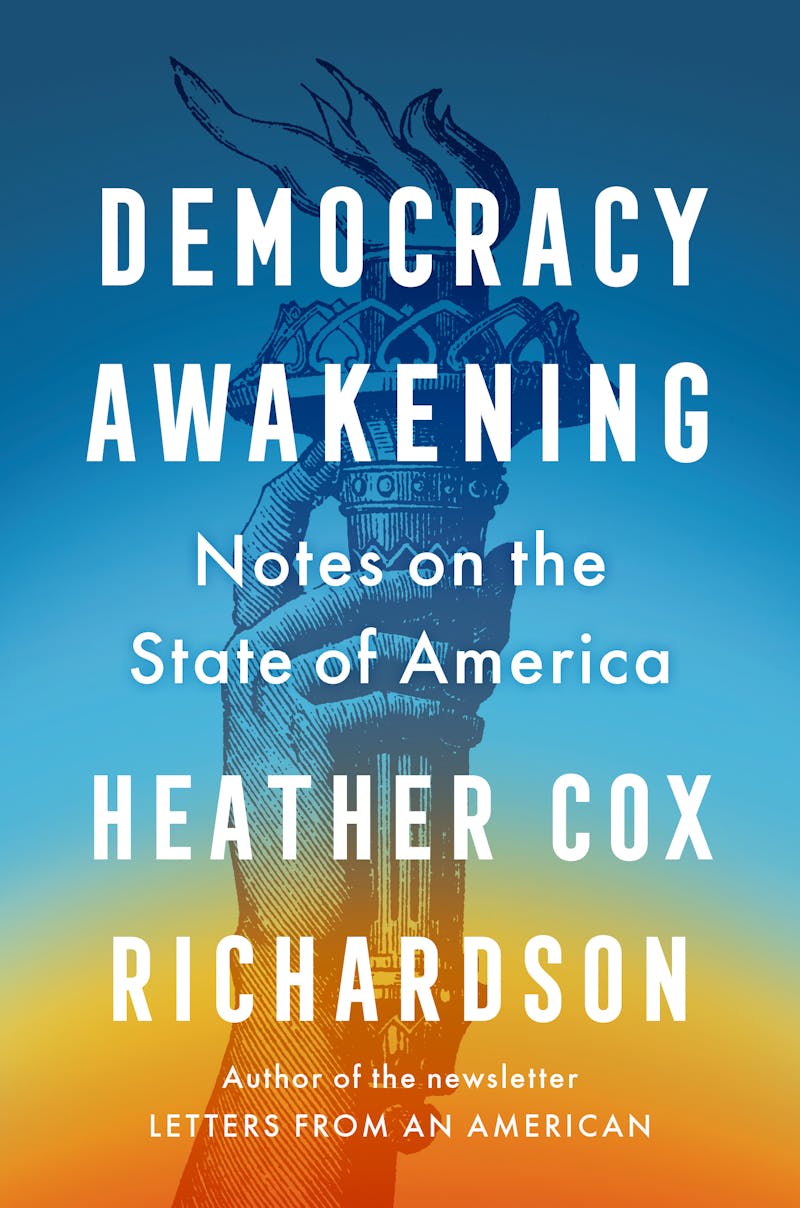I.
The Crisis Upon Us
America is at a crossroads.
A country that once stood as the global symbol of democracy has been teetering on the brink of authoritarianism.
How did this happen? Is the fall of democracy in the United States inevitable? And if not, how can we reclaim our democratic principles?

This crisis in American democracy crept up on many of us. For generations of Americans, grainy news footage from World War II showing row upon row of Nazi soldiers goose-stepping in military parades tricked us into thinking that the Adolf Hitlers of the world arrive at the head of giant armies. So long as we didn’t see tanks in our streets, we imagined that democracy was secure. But in fact, Hitler’s rise to absolute power began with his consolidation of political influence to win 36.8 percent of the vote in 1932, which he parlayed into a deal to become German chancellor. The absolute dictatorship came afterward.
Democracies die more often through the ballot box than at gunpoint.
But why would voters give away their power to autocrats who inevitably destroy their livelihoods and sometimes execute their neighbors?
In the aftermath of World War II, scholars invested a great deal of energy in trying to explain how, in the 1930s, ordinary Germans whose constitution was one of the most democratic in the world had been persuaded to stand behind a fascist government whose policies led to the destruction of cities, made millions homeless, and created such a shortage of food that Germans were eking by on less than 1,500 calories a day. That government also ultimately murdered six million Jews and millions more Slavs, Roma, sexual minorities, disabled individuals, and dissenters.
Social scientists noted that the economic and political instability in Germany after World War I was crucial for Hitler’s rise. But it took writers, philosophers, and historians to explain how authoritarians like Hitler harnessed societal instability into their own service.
The key to the rise of authoritarians, they explained, is their use of language and false history.
Authoritarians rise when economic, social, political, or religious change makes members of a formerly powerful group feel as if they have been left behind. Their frustration makes them vulnerable to leaders who promise to make them dominant again. A strongman downplays the real conditions that have created their problems and tells them that the only reason they have been dispossessed is that enemies have cheated them of power.
Such leaders undermine existing power structures, and as they collapse, people previously apathetic about politics turn into activists, not necessarily expecting a better life, but seeing themselves as heroes reclaiming the country. Leaders don’t try to persuade people to support real solutions, but instead reinforce their followers’ fantasy self-image and organize them into a mass movement. Once people internalize their leader’s propaganda, it doesn’t matter when pieces of it are proven to be lies, because it has become central to their identity.
As a strongman becomes more and more destructive, followers’ loyalty only increases. Having begun to treat their perceived enemies badly, they need to believe their victims deserve it. Turning against the leader who inspired such behavior would mean admitting they had been wrong and that they, not their enemies, are evil. This, they cannot do.
Having forged a dedicated following, a strongman warps history to galvanize his base into an authoritarian movement. He insists that his policies—which opponents loathe—simply follow established natural or religious rules his enemies have abandoned. Those rules portray society as based in hierarchies, rather than equality, and make the strongman’s followers better than their opponents. Following those “traditional” rules creates a clear path for a nation and can only lead to a good outcome. Failing to follow them will lead to terrible consequences.
Those studying the rise of authoritarianism after World War II believed these patterns were universal. Yet scholars in the United States noted that while countries around the world were falling to authoritarianism in the 1930s, the United States, sailing between the siren songs of fascism on the one side and communism on the other, had somehow avoided destruction.
This was no small thing. The United States was as rocked as any country by economic trouble and the collapse of authority it revealed and, in the 1930s, it had its own strong fascist movement with prominent spokespeople. Things had gone so far that in February 1939, in honor of President George Washington’s birthday, Nazis held a rally at New York City’s Madison Square Garden. More than twenty thousand people showed up for the “true Americanism” event, held on a stage that featured a huge portrait of Washington in his Continental Army uniform flanked by swastikas.
And yet, just two years later, Americans went to war against fascism. Within six years the United States was leading the defense of democracy around the world, never perfectly—indeed, often quite badly—but it had rejected authoritarianism in favor of the idea that all people are created equal.
Scholars studying the U.S. suggested that Americans were somehow different from those who had fallen to authoritarianism. They were too practical, too moderate, to embrace political extremes. They liked life in the middle.
II.
The Two Warring Visions of Society
It was a lovely thought, but it wasn’t true.
America took a different course in the 1930s not because Americans were immune to authoritarianism, but because they rallied around the language of human self-determination embodied in the Declaration of Independence.
They chose to root the United States not in an imagined heroic past, but in the country’s real history: the constant struggle of all Americans, from all races, ethnicities, genders, and abilities, to make the belief that we are all created equal and that we have a right to have a say in our democracy come true. People in the United States had never lost sight of the promise of democracy because marginalized people had kept it in the forefront of the national experience. From the very first days of the new nation, minorities and women had consistently, persistently, and bravely insisted on their right to equality before the law and to a say in their government.
In the 1930s their insistence translated into a defense of democracy around the world. President Franklin Delano Roosevelt clearly and repeatedly spelled out the difference between a society based on the idea that all people are equal and a society based on the idea that some people are better than others and have a right to rule.
Americans chose a free future by choosing a principled past. But they could have chosen differently.
In the 1930s the struggle between equality and inequality took shape as a fight between democracy and fascism. But while fascism was a newly articulated ideology in that era, the thinking on which it was based—that some people are better than others—had deep roots in the United States. From the nation’s beginning, the Founders’ embrace of equality depended on keeping women, Black Americans, and other people of color unequal.
That paradox had in it the potential for the rhetoric that authoritarians use, and in the past, those determined to undermine democracy have indeed gone down that road. Whenever it looked as if marginalized people might get an equal voice, designing political leaders told white men that their own rights were under attack. Soon, they warned, minorities and women would take over and push them aside.
Elite enslavers had done this in the 1850s and had come close to taking over the country. “We do not agree with the authors of the Declaration of Independence, that governments ‘derive their just powers from the consent of the governed,’” enslaver George Fitzhugh of Virginia wrote in 1857. “All governments must originate in force, and be continued by force.” There were 18,000 people in his county and only 1,200 could vote, he said, “but we twelve hundred ... never asked and never intend to ask the consent of the sixteen thousand eight hundred whom we govern.”
During the Civil War, the majority of Americans worked to defeat the enslavers’ new definition of the United States. Their victory on the battlefields made them think they had made sure that “government of the people, by the people, for the people, shall not perish from the earth.”
But the thinking behind the Confederacy—that people are inherently unequal and some should rule the rest—persisted.
That thinking has once again brought us to a crisis. In the years after 1980, a political minority took over Congress, the state legislatures, the courts, and the Electoral College, and by 2016 the Economist Intelligence Unit had downgraded the U.S. from a “full democracy” to a “flawed democracy.” By 2021, warnings had become more dire. Freedom House, a nonprofit that charts the health of democracies internationally, “urgently” called for reforms after a decade in which “US democracy has declined significantly.”
The election and then the presidency of Donald Trump hastened that decline. When the nation’s rising oligarchy met a budding authoritarian, the Republican Party embraced the opportunity to abandon democracy with surprising ease. In the four years of Trump’s presidency, his base began to look much like the one post–World War II scholars had identified: previously apathetic citizens turned into a movement based in heroic personal identity. Trump discarded the idea of equality before the law and scoffed at the notion that Americans had the right to choose their government. He and his followers embraced the false past of the Confederates and insisted they were simply trying to follow the nation’s traditional principles. Eventually, they tried to overturn the results of the 2020 presidential election to stay in power. And even after Trump had tried to undermine the principle of self-government on which the United States was founded, his followers stayed loyal.
Those justifying their embrace of authoritarianism as the future of government in the twenty-first century say that democracy is obsolete. Some argue that popular government responds too slowly to the rapid pace of the modern world and that strong countries need a leader who can make fast decisions without trying to create a consensus among the people.
Critics of liberal democracy say that its focus on individual rights undermines the traditional values that hold societies together, values like religion and ethnic or racial similarities. Religious extremists have tried to tie their destruction of democracy into our history by insisting that the Founders believed that citizens must be virtuous, and that religion alone can create virtue. By this line of thought, imposing religious values on our country is exactly what the Founders intended.
I don’t buy it.
The concept that humans have the right to determine their own fate remains as true today as it was when the Founders put that statement into the Declaration of Independence, a statement so radical that even they did not understand its full implications. It is as true today as it was when FDR and the United States stood firm on it. With today’s increasingly connected global world, that concept is even more important now than it was when our Founders declared that no one had an inherent right to rule over anyone else, that we are all created equal, and that we have a right to consent to our government.
III.
Reclaiming Our Country
When Americans elected Democratic President Joe Biden in 2020, he made it clear that he intended to defend American democracy from rising authoritarianism. Throughout his campaign, he focused on bringing people in the center-right and center-left together, just as scholars of authoritarianism have called for. Biden ignored Trump and pledged to work with Republicans who believe in “the rule of law and not the rule of a single man.”
On January 6, 2022, the one-year anniversary of the attack on the U.S. Capitol and on the right of Americans to choose their leaders, Biden explicitly defended traditional American values.
“Those who stormed this Capitol and those who instigated and incited and those who called on them to do so” acted “not in service of America, but rather in service of one man” who “has created and spread a web of lies about the 2020 election ... because he values power over principle, because he sees his own interests as more important than his country’s interests and America’s interests, and because his bruised ego matters more to him than our democracy or our Constitution,” Biden told the American people. He urged Americans not to succumb to autocracy, but to come together to defend our democracy, “to keep the promise of America alive,” and to protect what we stand for: “the right to vote, the right to govern ourselves, the right to determine our own destiny.”
Once sworn into office, Biden set out to demonstrate that the government could work for ordinary people. In his first two years in office, with a slender majority in the House of Representatives and a Senate split 50–50, the Democrats managed to pass historic legislation that echoed that of FDR and LBJ, shoring up the economy, rebuilding the country’s infrastructure, and investing in the future, trying to bring the disaffected Americans who had given up on democracy back into the fold. Biden’s domestic program expanded liberalism to meet the civil rights demands of our time just as Abraham Lincoln, Theodore Roosevelt, FDR, and LBJ had each expanded liberalism to meet the challenges of westward expansion, industrialization, globalization, and anti-colonialism.
Biden knew that defending democracy at home meant strengthening it internationally. In his first speech to the State Department, on February 4, 2021, he emphasized that once again, “America’s most cherished democratic values” would be at the center of American diplomacy: “defending freedom, championing opportunity, upholding universal rights, respecting the rule of law, and treating every person with dignity.”
The power of that defense became clear in February 2022, when Vladimir Putin launched a new invasion of Ukraine. Putin was stymied by Ukraine’s soldiers, who had trained hard in the eight years since the first Russian invasion, and by an international community that refused to recognize Russia’s land grab, imposed strict and coordinated sanctions, and provided Ukraine with money, intelligence, and weapons. This community stood together in no small part thanks to Biden and Secretary of State Antony J. Blinken, and the strength in that cooperation discredited the argument that autocracy was more efficient and powerful than democracy.
But despite the emerging defense of democracy, Trumpism did not die. Trump and his loyalists continued to insist he had won the 2020 election, while extremists like newly elected Georgia Representative Marjorie Taylor Greene, who has endorsed the idea that some Democratic politicians should be executed, told a right-wing newspaper that there was no difference between establishment Republicans and Democrats. She said she was eager to bring more action-oriented people like her to Congress to help Trump with his plan, “whenever he comes out with [it].”
Establishment leaders swung behind the Trump faction, especially after June 2022, when the Supreme Court, packed by then–Senate Majority Leader Mitch McConnell with three extremist judges, ignored the precedent they had promised to respect and overturned the 1973 Roe v. Wade decision legalizing abortion.
Republican leaders went on to challenge many of the court decisions protecting the liberal consensus government in place since the 1930s. If the Fourteenth Amendment did not protect abortion, the other civil rights it protected were on the table, including gay marriage, the right to contraception, and perhaps even desegregation. Also on the table was the government regulation of business.
Meanwhile, Trump’s political star had begun to fall as his legal and financial troubles mounted in the years after the election. But he had radicalized the Republican Party, and Republican governors competed to pick up his voters. Unlike Trump in 2016, though, they made no pretense of embracing the Reagan Republican ideology of free markets: Florida Governor Ron DeSantis, for instance, openly used the power of his office to reward political friends and punish those he perceived as his enemies and to manufacture anti-immigrant and anti-LGBTQ sentiment, much as Putin and Viktor Orbán had done before him. Right-wing thinkers began to argue openly that democracy and its values—equality before the law, separation of church and state, an independent press, academic freedom, and free markets—have undermined the human virtue of the past and must be stamped out.
Crucially, those efforts depended on maintaining the right-wing myth that American history was rooted in a pure past that their opponents were destroying. Early in Biden’s term, Republican operatives manufactured outrage over the alleged teaching of critical race theory in public schools. That legal theory, designed to explain why the laws of the 1960s hadn’t created the equality they promised, was an upper-level law school elective that had never actually been taught in public schools. Republican-dominated legislatures passed laws forbidding teachers from teaching “CRT” or any lesson suggesting that the American system might ever have had systemic inequalities, or even lessons that might make some people—by which they meant white people—uncomfortable. Hand in hand with that censorship went a surge in book banning from the public schools and from some public libraries, with most of the banned books written by or about Black or LGBTQ people.
A history that looks back to a mythologized past as the country’s perfect time is a key tool of authoritarians. It allows them to characterize anyone who opposes them as an enemy of the country’s great destiny.
But the true history of American democracy is that it is never finished. It is the story of people who have honored the idea that a nation can be based not in land or religion or race or hierarchies, but rather in the concept of human equality. That commitment, along with its corollary—that we have a right to consent to our government, which in turn should act in our interest—has brought us our powerful history of people working and sacrificing to bring those principles to life. Reclaiming our history of noble struggle reworks the polarizing language that has done us such disservice while it undermines the ideology of authoritarianism.
In 1776, with all their limitations, the Founders proposed that it was possible to create a nation based not in religion or race or hierarchies of wealth or tradition, but in the rule of law. It was possible, at least in principle, they thought, to bring widely different peoples together in a system in which every person was equal before the law and entitled to a voice in government. They set out to show that it could be done.
That theory was never unchallenged. In the 1850s, a reactionary and wealthy minority tried to get rid of it altogether, insisting that true “democracy” centered power in the state governments that they controlled.
But that story didn’t end as the elite enslavers wished.
Men like Abraham Lincoln recognized that such a struggle was not just about who got elected to the White House. It was the story of humanity, “the eternal struggle between these two principles—right and wrong—throughout the world.” Lincoln made it clear that those who wanted the right to self-determination had always had to struggle—and would always have to struggle—against those who wanted power. “The one is the common right of humanity and the other the divine right of kings. It is the same principle in whatever shape it develops itself,” he said. “No matter in what shape it comes, whether from the mouth of a king who seeks to bestride the people of his own nation and live by the fruit of their labor, or from one race of men as an apology for enslaving another race, it is the same tyrannical principle.”
When Lincoln said those words in 1858, it was not at all clear his vision would prevail. But he had hope because, after decades in which they had not noticed what the powerful were doing to destroy democracy, Americans had woken up. They realized that the very nature of America was under attack. They were divided among themselves, and at first they didn’t really know how to fight back, but ordinary people quickly came to pitch in however they could, using the tools they had. “We rose each fighting, grasping whatever he could first reach—a scythe—a pitchfork—a chopping axe, or a butcher’s cleaver,” Lincoln recalled. Once awake, they found the strength of their majority.
In Lincoln’s era, democracy appeared to have won. But the Americans of Lincoln’s time did not root out the hierarchical strand of our history, leaving it there for other rising autocrats in the future to exploit with their rhetoric and the fears of their followers.
So far, the hopes of our Founders have never been proven fully right. And yet they have not been proven entirely wrong.
Once again, we are at a time of testing.
How it comes out rests, as it always has, in our own hands.
From the book Democracy Awakening by Heather Cox Richardson, published by Viking, an imprint of Penguin Publishing Group, a division of Penguin Random House LLC. Copyright © 2023 by Heather Cox Richardson.
This excerpt has been edited for length and clarity.




